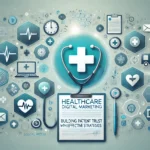Healthcare Digital Marketing: Building Patient Trust with Effective Strategies
The landscape of healthcare marketing has undergone a transformative shift in recent years, propelled by advancements in technology and the rise of digital communication channels. As healthcare providers and organizations strive to connect with patients in more meaningful ways, digital marketing emerges as a crucial tool. The challenge lies in building patient trust, a cornerstone for successful healthcare interactions. This article explores effective strategies in healthcare digital marketing, aiming to foster trust and enhance patient engagement in an increasingly digital world.
Understanding the Digital Shift in Healthcare
The digital revolution has reshaped every industry, and healthcare is no exception. With the proliferation of smartphones, wearable technology, and internet access, patients are more empowered than ever before to take an active role in their healthcare decisions. This shift has prompted healthcare providers to transition from traditional marketing methods to digital platforms, where information is readily available and easily accessible. In this new digital era, the patient journey begins long before they set foot in a doctor’s office, often starting with an online search.
In response to these changes, healthcare organizations are adopting digital marketing strategies that prioritize patient needs and preferences. This includes optimizing websites for mobile devices, utilizing search engine optimization (SEO) to ensure visibility, and creating user-friendly interfaces that facilitate easy navigation. By understanding the digital behaviors and expectations of patients, healthcare providers can tailor their marketing efforts to create a seamless and engaging online experience.
Moreover, the digital shift has opened new avenues for personalized communication, allowing healthcare providers to connect with patients on a more individualized level. Through data analytics and patient segmentation, organizations can deliver targeted messages that resonate with specific patient groups. This not only enhances engagement but also builds a foundation of trust, as patients perceive the communication as relevant and attentive to their unique needs.
Crafting a Patient-Centric Online Presence
A patient-centric online presence is essential for building trust and fostering meaningful relationships with patients. This begins with a well-designed website that serves as the digital front door to a healthcare organization. A user-friendly interface, clear navigation, and accessible information are critical components that contribute to a positive first impression. Patients should be able to find what they’re looking for quickly and easily, whether it’s information about services, contact details, or educational resources.
Furthermore, the content presented on the website should reflect a deep understanding of patient concerns and priorities. This includes providing detailed information about medical conditions, treatment options, and healthcare practitioners. By anticipating and addressing patient questions and concerns, healthcare organizations can demonstrate their commitment to patient education and empowerment. Incorporating patient testimonials and success stories can also add a layer of authenticity and trustworthiness.
In addition to an informative website, healthcare providers should prioritize the integration of digital tools that enhance the patient experience. Online appointment scheduling, telemedicine services, and patient portals are just a few examples of how technology can streamline healthcare processes and make them more convenient for patients. By focusing on patient-centric solutions, healthcare marketers can build a strong online presence that resonates with patients and fosters lasting trust.
Building Trust Through Transparent Communication
Transparent communication is the bedrock of trust in any relationship, and healthcare is no different. Patients want to feel informed and respected, especially when it comes to their health. Healthcare providers can foster trust by being open and honest in their communications, whether it’s explaining a diagnosis, discussing treatment options, or addressing potential risks and side effects. Transparency helps patients make informed decisions and reassures them that their healthcare provider values their autonomy and well-being.
Digital platforms offer numerous opportunities for transparent communication. Providers can use blogs, webinars, and social media to share insights and updates about medical advancements, policy changes, and their own practices. This not only keeps patients informed but also demystifies the healthcare experience, making it less intimidating and more approachable. Regularly updated content shows patients that the organization is actively engaged in its mission to provide high-quality care.
It’s also important for healthcare providers to actively listen to patient feedback and respond with empathy and understanding. Online reviews, surveys, and feedback forms are valuable tools for gathering patient input. By acknowledging patient concerns and taking steps to address them, healthcare organizations demonstrate their commitment to continuous improvement and patient satisfaction. This proactive approach to communication not only builds trust but also strengthens the overall patient-provider relationship.
Leveraging Social Media for Patient Engagement
Social media has become an indispensable tool in the healthcare digital marketing arsenal, offering a dynamic platform for patient engagement and community building. With billions of users worldwide, platforms like Facebook, Twitter, Instagram, and LinkedIn allow healthcare providers to reach a broad audience and share valuable content in real time. Through social media, organizations can humanize their brand, showcase their expertise, and interact with patients in meaningful ways.
To effectively leverage social media, healthcare marketers should focus on creating content that resonates with their target audience. This can include educational posts, health tips, patient testimonials, and behind-the-scenes glimpses of healthcare practices. Visual content, such as infographics and videos, often performs well on social media and can help convey complex medical information in an easily digestible format. By providing valuable and engaging content, healthcare providers can position themselves as trusted resources in the digital space.
Engagement is key on social media, and healthcare providers should actively participate in conversations with their followers. Responding to comments, answering questions, and acknowledging patient feedback fosters a sense of community and trust. Social media can also be used to address misconceptions and provide clarifications, further establishing the provider as a reliable source of information. By maintaining an active and responsive social media presence, healthcare organizations can strengthen patient relationships and enhance their overall reputation.
Utilizing Content Marketing to Educate Patients
Content marketing is a powerful strategy for educating patients and building trust in the healthcare sector. By providing valuable, informative, and relevant content, healthcare organizations can position themselves as thought leaders and trusted advisors. Educational content helps demystify complex medical topics, empowering patients to make informed decisions about their health and treatment options.
Healthcare providers can utilize a variety of content formats to reach and engage their audience. Blogs, articles, and white papers are excellent for delivering in-depth information, while videos, webinars, and podcasts offer more dynamic and interactive ways to educate patients. Infographics and visual aids simplify complex data and concepts, making them more accessible and understandable. By leveraging a mix of content types, healthcare organizations can cater to diverse learning preferences and reach a broader audience.
The key to successful content marketing lies in understanding the needs and interests of the target audience. By conducting research and gathering insights about patient demographics, concerns, and preferences, healthcare marketers can tailor their content to address specific questions and pain points. Regularly updating and refreshing content ensures that it remains relevant and valuable to patients. By prioritizing patient education through content marketing, healthcare providers can build lasting trust and loyalty among their audience.
Enhancing Patient Experience with Technology
In today’s digital age, technology plays a pivotal role in enhancing the patient experience and building trust. From telemedicine to mobile health apps, technological advancements have transformed how patients interact with healthcare providers. These innovations offer convenience, accessibility, and personalization, which are highly valued by patients seeking efficient and effective healthcare solutions.
Telemedicine, for instance, has gained significant traction, especially in the wake of the COVID-19 pandemic. It allows patients to consult with healthcare providers remotely, reducing the need for in-person visits and increasing accessibility to care. This technology not only expands the reach of healthcare services but also provides a sense of security and continuity for patients. By offering telemedicine options, healthcare providers demonstrate their commitment to adapting to patient needs and embracing modern solutions.
Patient portals and mobile health apps further enhance the patient experience by providing easy access to medical records, appointment scheduling, and personalized health information. These digital tools empower patients to take an active role in managing their health and wellness. By integrating technology into healthcare processes, providers can streamline communication, improve patient satisfaction, and ultimately build trust in their services. As patients increasingly seek tech-driven solutions, embracing technology becomes an essential strategy in healthcare digital marketing.
Measuring Success: Analytics in Healthcare Marketing
Analytics plays a crucial role in evaluating the effectiveness of healthcare digital marketing strategies. By collecting and analyzing data, healthcare organizations can gain valuable insights into patient behavior, preferences, and engagement patterns. These insights enable marketers to make informed decisions, optimize campaigns, and allocate resources more effectively. In the context of building patient trust, analytics can help identify areas for improvement and highlight successful initiatives.
Healthcare marketers can leverage a variety of analytics tools to track key performance indicators (KPIs) and measure the success of their digital marketing efforts. Website analytics, for instance, provide information on visitor demographics, traffic sources, and user behavior. Social media analytics offer insights into engagement metrics, such as likes, shares, and comments. Email marketing platforms track open and click-through rates, helping marketers gauge the effectiveness of their communication strategies.
In addition to quantitative data, qualitative feedback from patients is invaluable for understanding the impact of digital marketing initiatives. Surveys, focus groups, and online reviews provide rich insights into patient perceptions and experiences. By combining quantitative and qualitative data, healthcare organizations can develop a comprehensive understanding of their marketing performance and identify opportunities to enhance patient trust and engagement. Continuous monitoring and analysis ensure that marketing strategies remain relevant and impactful in a rapidly evolving healthcare landscape.
Future Trends in Healthcare Digital Marketing
As technology continues to evolve, so too will the landscape of healthcare digital marketing. One of the most promising trends is the increasing use of artificial intelligence (AI) and machine learning to personalize patient interactions. AI-driven chatbots, for example, can provide instant responses to patient inquiries, improving accessibility and efficiency. By leveraging AI, healthcare providers can deliver tailored content and recommendations, enhancing the overall patient experience.
Another emerging trend is the integration of virtual and augmented reality (VR/AR) in healthcare marketing. These immersive technologies offer unique opportunities for patient education and engagement. Virtual tours of healthcare facilities, interactive simulations of medical procedures, and AR-powered educational tools can enhance patient understanding and confidence. As VR/AR technology becomes more mainstream, it has the potential to revolutionize how patients interact with healthcare information.
Furthermore, the growing emphasis on data privacy and security will shape the future of healthcare digital marketing. As patients become more aware of the importance of protecting their








